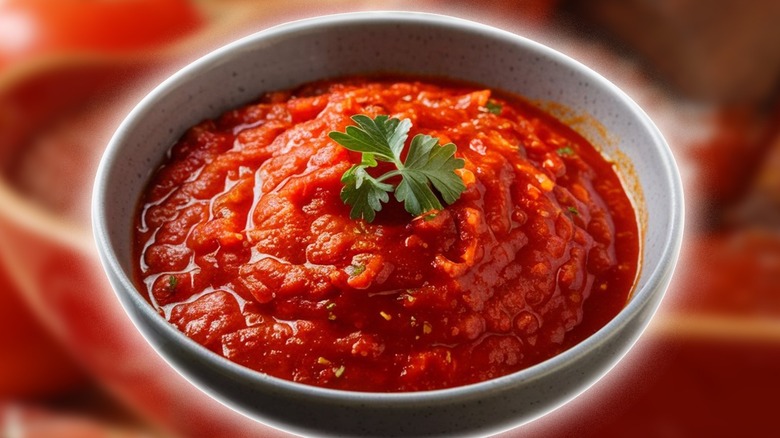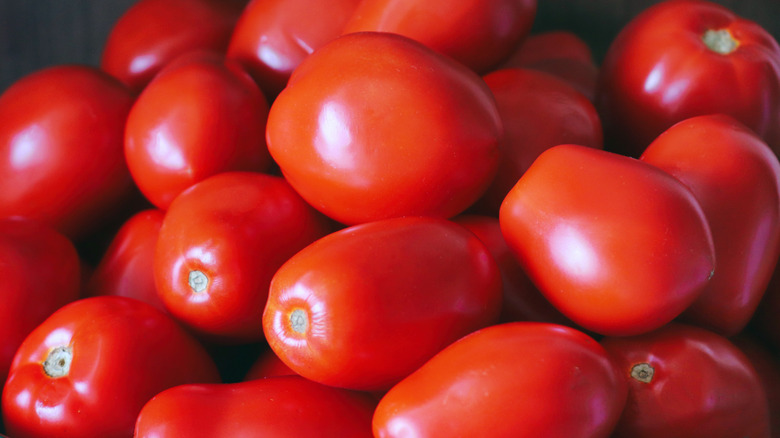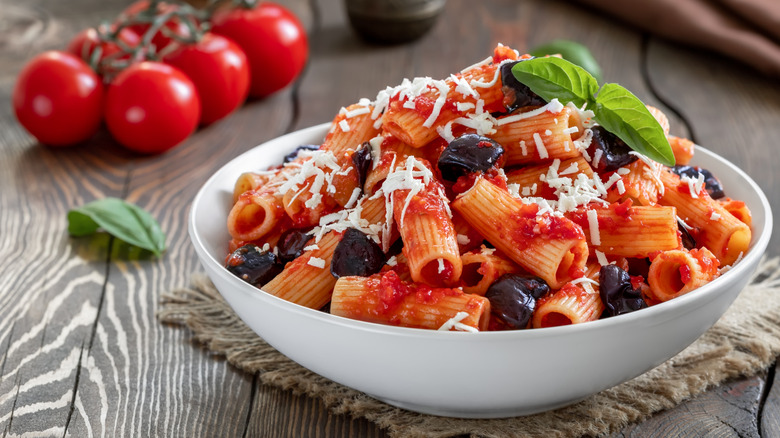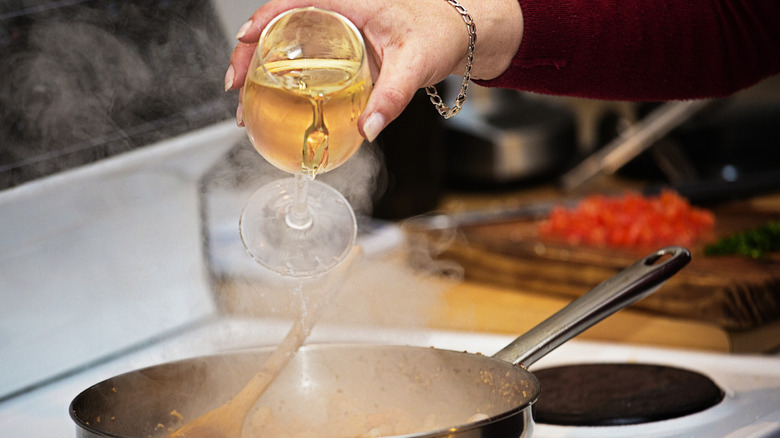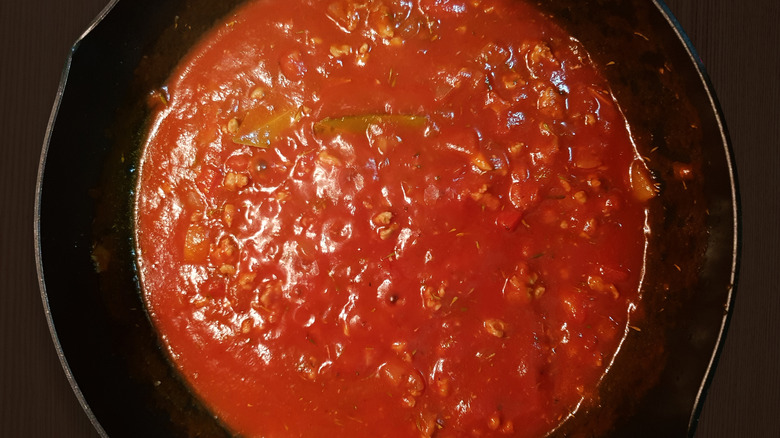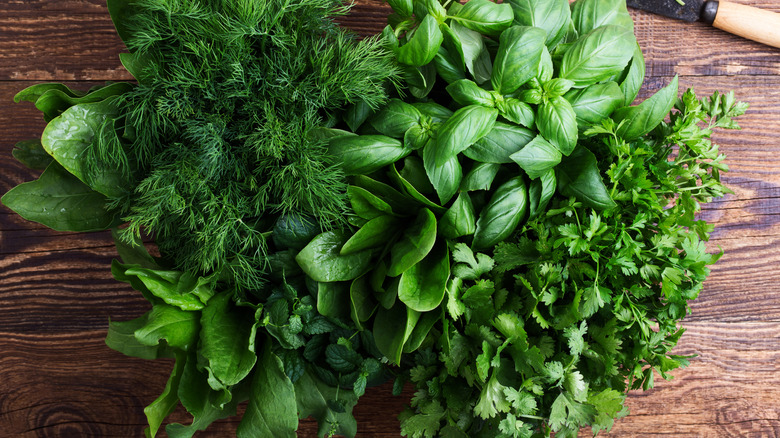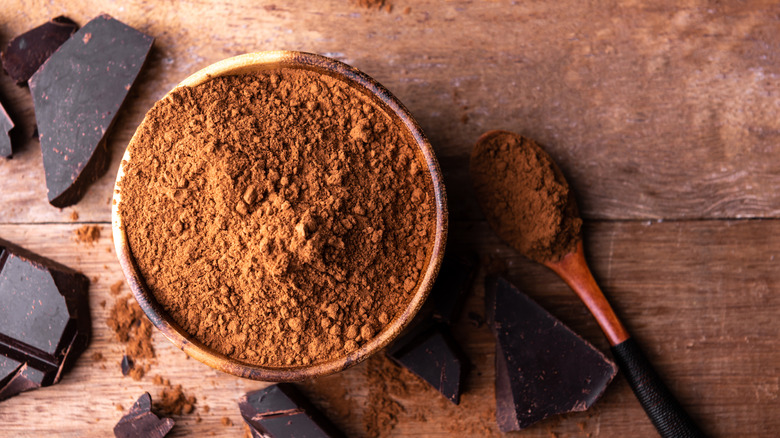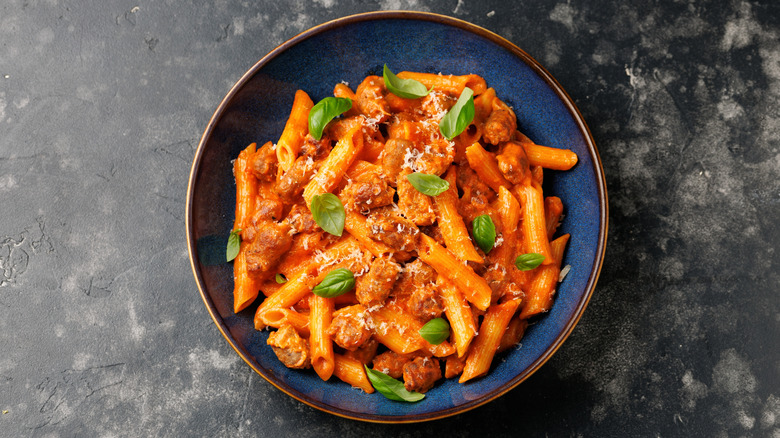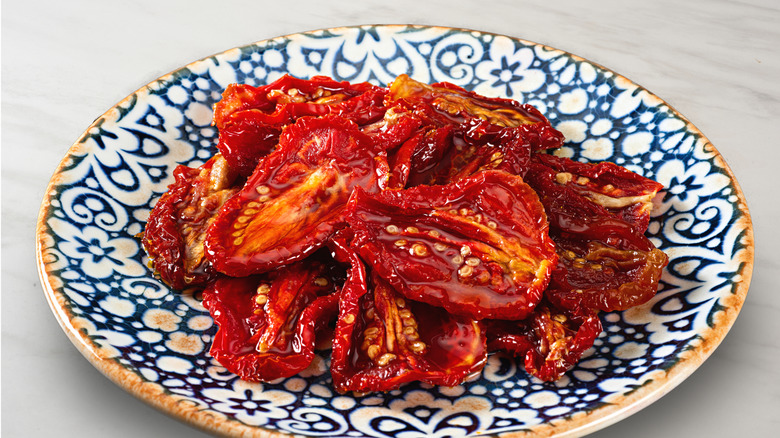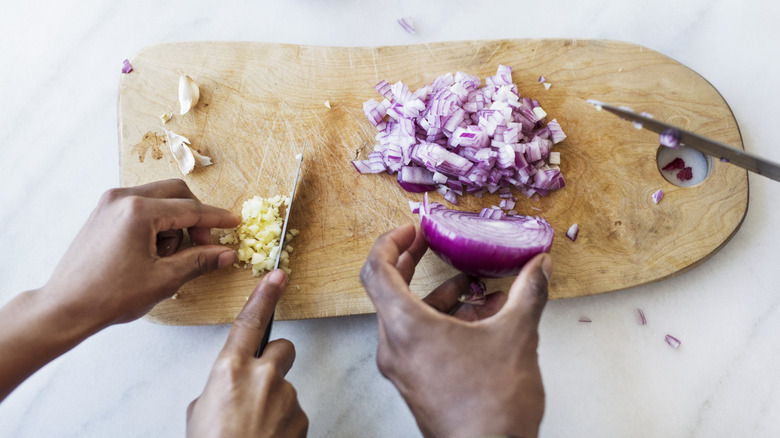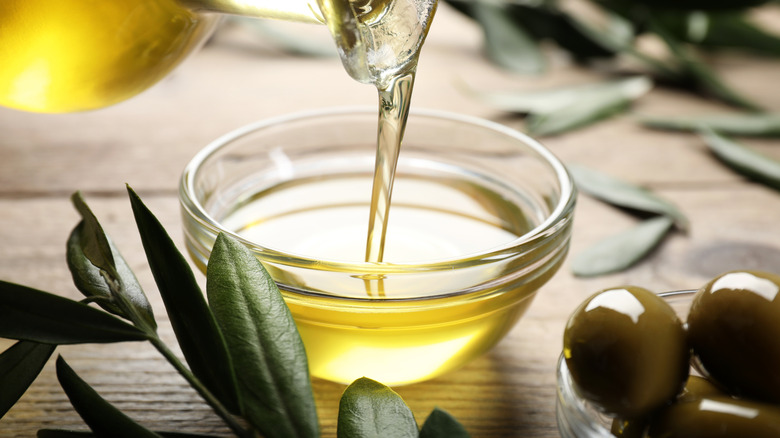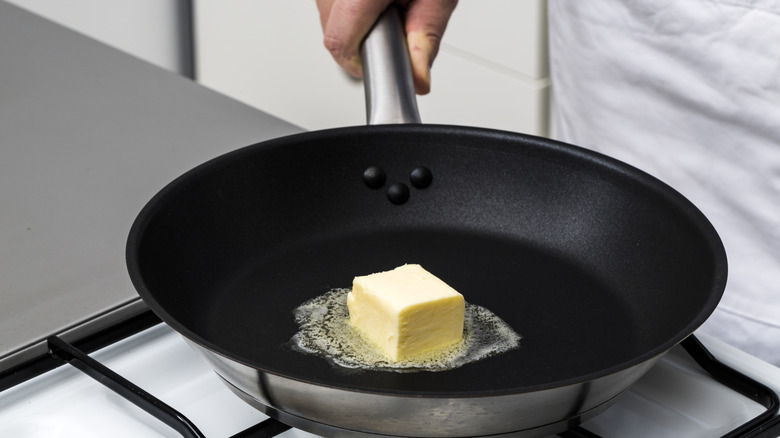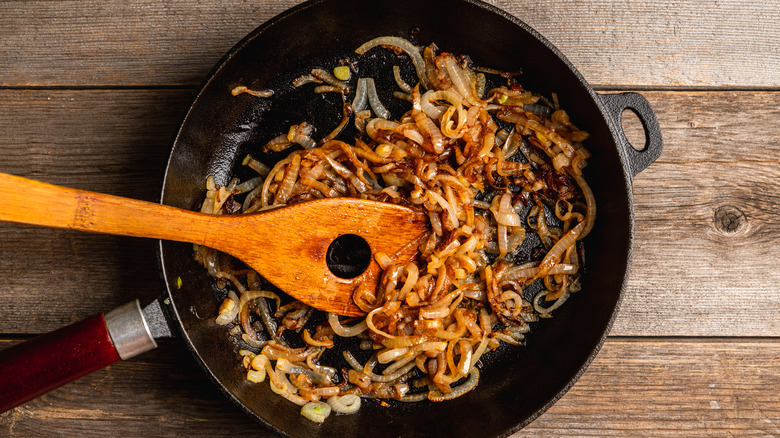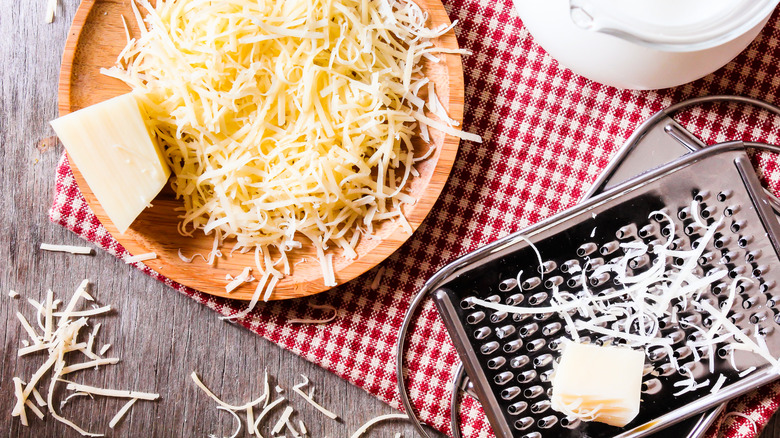13 Ways To Upgrade Homemade Marinara Sauce
We may receive a commission on purchases made from links.
Marinara is a classic Italian sauce that can be used for pasta, for pizza, or for dipping. Part of its beauty lies in its simplicity, but even so, don't you sometimes find it a bit boring? You might be looking for ways to upgrade your homemade marinara sauce, whether that's by adding extra ingredients or upgrading your regular ingredients for higher quality versions. We've compiled our top tweaks and additions to take your sauce to the next level.
You might want to start with your favorite marinara sauce recipe — or perhaps you're aiming to find a better one. Either way, you can apply these upgrades to any version you make from scratch. From swapping regular canned tomatoes for fresh or fire-roasted ones to simmering your sauce for longer or adding a healthy dose of cheese, there are many ways to give this sauce a boost.
We're not saying that you have to completely reinvent the wheel when it comes to marinara sauce, but if your recent attempts have been lackluster, you can use these upgrades. You won't believe how much tastier your finished sauce can be with just a few changes. It's all about understanding the basics of cooking and how they can improve the outcome. Try any of these 13 ways to upgrade homemade marinara sauce — either individually or combined — and taste the difference.
1. Use fresh tomatoes instead of canned
One simple way to give a tired old marinara sauce recipe a new lease of life is to use fresh tomatoes instead of canned. This is a particularly great idea when tomatoes are in season and at their most delicious. The flavor difference is clear from the first bite. Tomato-based sauces made with fresh tomatoes are lighter and brighter than those made with canned varieties. Sometimes what you want from a marinara sauce is the deep, rich flavor of canned tomatoes, but there's room for a change. And that's where fresh tomatoes come into play.
If you decide to go down this route, it's a good idea to learn more about tomato varieties and how to cook with them. Some are a better choice for sauce than others. For instance, large plum varieties, such as San Marzano and Roma, are perfect in sauces. The secret is that these also belong to the paste tomato family. Paste tomatoes tend to be fairly firm without too high of a water content, so they make a robust, flavorful sauce. However, there are other non-plum paste tomatoes, such as Amish Paste and Opalka tomatoes, that work, too.
The only downside is that, if you want a smooth sauce, you'll need to remove the skins from the tomatoes. There are some tips for easily peeling tomatoes, but it's still a little fiddly, which might put some people off.
2. Try fire-roasted tomatoes
What if you don't have access to great fresh tomatoes? You can still change the type of tomatoes you use in your marinara sauce while continuing to get them from a can. You'll find many types of canned tomatoes on grocery store shelves. And, if you haven't yet tried fire-roasted tomatoes, now's your chance.
As the name suggests, fire-roasted tomatoes are roasted over an open flame before canning. This gives them a rich, deep, smoky flavor. Some people find this flavor strong and prefer to use fire-roasted tomatoes only in dishes that are smoky anyway. However, we think this is limiting. If you like smoky flavors in your food, using fire-roasted tomatoes in a marinara sauce is a no-brainer.
What's cool about making the switch is that you don't have to make any other adjustments (unless you want to). Your favorite recipe will behave exactly the same way whether you use regular canned tomatoes or fire-roasted tomatoes.
3. Level up marinara sauce with wine
You can use wine to make marinara sauce even tastier. This can seem daunting if you aren't used to cooking with wine, but it's actually quite simple. Wine brings a depth of flavor to sauces without being too boozy or even having the obvious flavor of wine — as long as you know how to work with it.
You can use either red wine or white wine in marinara sauce. Red is often the go-to choice for marinara sauce. Its robust flavor stands up well against the richness and depth of tomato sauce. It brings its deep tannic notes and makes a memorable meal. However, white wine has its place, too. It makes a slightly more subtle addition but still brings extra flavor to the sauce. It ends up a little brighter and less heavy than marinara made with red wine.
The trouble is, you can't just throw the wine in your sauce at any point and hope for the best. There are all kinds of mistakes people make when cooking with wine that you need to avoid. When making marinara sauce, you'll generally want the wine to cook off to deepen the flavor. This means that you should add it to the aromatics toward the beginning and let it simmer for a while before adding the tomatoes. You can also use wine to deglaze the pan while you're cooking the onions and garlic.
4. Give your marinara sauce a long, slow simmer
Marinara is generally considered a fairly quick sauce. It doesn't have the all-day cooking times that you'll find with some classic Italian tomato sauces. When you're in a hurry, this is a great thing. However, simmering concentrates the flavors, making tomato sauce taste richer and more deeply savory. So, a slow-simmered marinara sauce can be transcendent.
If you want to give this a whirl, start off as you usually would with marinara sauce. Once you've gotten to the point where all the ingredients have been added and the sauce has started to simmer, turn your stove down as low as it will go and let it hang out there for a while. But, how long should you simmer homemade tomato sauce? Most marinara sauces call for around a 30-minute simmering time. This is the bare minimum for developing a decent amount of flavor. If you want a deep, flavorful sauce, simmer it for at least three hours. This might sound like a lot of work, but once it gets going, you only need to stir it occasionally.
5. Use fresh herbs instead of dried
Marinara sauce usually contains dried herbs — predominantly oregano. But you can easily mix things up by using fresh herbs instead of dried ones. The difference between fresh and dried herbs can be significant. It's not that one is always better than the other. They're just different. Dried oregano is flavorful yet fairly mild. The fresh stuff is sharper with a more peppery flavor. You might find that fresh oregano isn't your bag, but you don't have to stick to oregano.
Fresh thyme is delicious in marinara sauce. It's complex with floral notes that shine against the rich acidity of the tomatoes. Rosemary is another great addition. It's a little woody and bitter but with some almost menthol notes. And, of course, fresh basil is a classic addition to any Italian dish. But, experiment with any herbs you like. Just know that some will work better than others.
Woody herbs, such as rosemary and thyme, can be incorporated into your cooking when you add the tomatoes. Chuck a stick or two of fresh herbs in the sauce so the flavor comes through, then remove them when the sauce is done. Soft herbs, such as basil and parsley, lose flavor as they cook, so they should be added just a couple of minutes before the end of the cooking time.
6. Add a little cocoa or instant coffee to your marinara sauce
It might seem strange, but cocoa powder or instant coffee are the secret ingredients you should be adding to your marinara sauce. They make the sauce taste richer and more complex without letting their own flavor shine through. So, it won't end up tasting like you've poured your morning coffee into your pasta sauce.
Cocoa and coffee both have a slightly bitter taste. This bitterness helps balance out the sweetness of the tomatoes in the sauce. These ingredients also make the sauce taste deeper and more interesting. They ultimately make the umami notes in the sauce seem stronger, so it tastes even more savory and delicious.
It might be counterintuitive, but you really can add instant coffee to your pasta sauce. Not much, though — just a teaspoon per pound of tomatoes. The same goes for cocoa powder. You just need a little to add that richness to the sauce without making it taste like a hot chocolate. You can also add dark chocolate to marinara sauce if you prefer. No more than an ounce per 28-ounce can of tomatoes. It's fine if the chocolate is semi-sweet, but avoid any that contains vanilla essence or other flavorings that might affect the finished dish.
7. Turn marinara sauce into a rose sauce with heavy cream
Fancy something a bit creamier than your average marinara sauce? You can easily transform it into a rose sauce by adding heavy cream. Sure, it's no longer a classic marinara, but for some, this is a total upgrade.
All you need to do is make your marinara sauce as usual. When it is finished cooking, add about a half a cup of heavy cream for every 28-ounce can of tomatoes you used in your sauce. Stir it in, and keep the sauce over a low heat for a few minutes, just so that it's warmed through. Don't let the sauce boil at this stage or it could split. If you don't eat dairy products, you could use homemade cashew cream or commercial soy or oat cream instead.
The resulting rose sauce is delicious with pasta dishes. It also makes a nice sauce to go on the side of mozzarella sticks, garlic knots, or pretty much anything else you can dip in it.
8. Boost flavor with umami ingredients
Umami is often called the fifth taste, along with sweet, sour, salty, and bitter. It's a savory, meaty flavor that makes food taste rich and satisfying. Cooked mushrooms, aged cheese, and soy sauce all have that deep umami flavor — along with a range of other foods.
Umami brings depth to dishes and makes them more flavorful. It's why adding a bit of Parmesan cheese to risotto or using rich broth in a soup can make the whole meal taste better. Adding umami ingredients to homemade marinara sauce is a surefire way to upgrade it.
One way to add an umami boost to marinara is with fish sauce. It might sound a little odd, but you don't add enough to make it taste fishy, just enough to bolster those savory notes in the sauce. Other ingredients that can bring a hit of umami to marinara include anchovies, sun-dried tomatoes, sun-dried tomato paste, monosodium glutamate (MSG), Worcestershire sauce, dashi stock, and yeast extracts, such as Marmite. Add them at the same time as the tomatoes, and let them simmer with the other ingredients to infuse the sauce with that delicious savory flavor.
9. Use fresh onion and garlic instead of the powdered kind
We know how tempting it is to take shortcuts when cooking. Some of them are totally worthwhile, saving time without sacrificing flavor. But, if you've been using garlic granules and onion powder in your marinara sauce instead of fresh onion and garlic, that needs to stop. Making the simple switch to the fresh stuff will instantly level up your sauce.
Great marinara sauce always uses fresh onions and garlic. Yes, it takes a bit of time to chop them, but those few extra minutes are well worth it for the improved flavor. Start by cooking your diced onions for about 5 to 7 minutes until they're starting to soften and have turned translucent. Then, add the garlic, and cook for a few more minutes until it's fragrant. This stops the garlic from burning, which can happen if you add it at the same time as the onions. At this stage, you can add the tomatoes and other ingredients. So, sure, it's more time-consuming than just throwing in powdered onion and garlic, but it tastes so much better.
10. Add plenty of olive oil
People are often hesitant to add too much oil to dishes because of the fat content. But get over it — fat makes food more delicious, and it's essential for our bodies. If you want to take your homemade marinara to the next level, you shouldn't be stingy with the olive oil.
Although some recipes use minimal oil, others call for up to ¼ cup of olive oil for an average pot of sauce made with 28 ounces of tomatoes. And, the difference in flavor is obvious when you try it. Some people will tell you not to cook with extra-virgin olive oil because of its lower smoke point, but the temperature doesn't get high enough when making a dish like this for that to be relevant. So, absolutely reach for extra-virgin olive oil and its rich, peppery flavors. Don't use the highest quality stuff — that should be reserved for drizzling — but an average extra-virgin olive oil is great to cook with.
11. Use butter in place of oil
Yes, we know that we just espoused the virtues of using extra-virgin olive oil in marinara sauce. But another way to upgrade your sauce is to use butter in place of oil. It's not that butter is better than olive oil or vice versa, but it brings a different flavor profile. So, if you're in a marinara rut and trying to change things up, this might be the ticket. Where extra-virgin olive oil brings a peppery bite, butter brings a mellow richness that many people love.
And, before anyone says this is an affront to Italian food, butter is actually a more common ingredient in Italian cooking than you might realize — especially in the northern part of the country. Iconic Italian cook Marcella Hazan has a famous tomato sauce recipe that uses nothing but butter, onions, tomatoes, and salt. You can also simply incorporate butter into your current favorite marinara recipe. Instead of sautéing onions and garlic in olive oil, use a few tablespoons of butter.
12. Try caramelized onions and roasted garlic for extra flavor
Caramelized onions and roasted garlic can bring a depth of flavor to marinara sauce that regular sautéed onions and garlic can't. It takes a bit more time to roast garlic and caramelize onions, but the flavor gains are real.
Caramelizing onions is simple but requires patience. You need to cook onions slowly over a low heat in your fat of choice, stirring every few minutes. As the onions cook, you'll see them change color, first turning golden and then brown. The whole process takes about 30 to 40 minutes. At that point, you can add the tomatoes and other ingredients and simmer.
Roasted garlic is sweeter and milder than sautéed garlic, so you can use a full bulb in a batch of marinara to bring loads of flavor without overwhelming the dish. To roast it, take a whole head of garlic and cut off the top to expose the cloves inside. Wrap the garlic in foil and roast for about 40 minutes in an oven at 400 degrees Fahrenheit. When it's done, the garlic will be soft and golden. Let it cool for a bit before you handle it. To use the roasted garlic, simply squeeze the bottom of the head, and the soft, creamy cloves will pop out. You can mash these and mix them into your sauce.
13. Add Parmesan for a cheesy twist
Cheese and marinara sauce go hand in hand. You'd add grated cheese to your pasta or pile cheese on top of pizza, so why not add it straight to the sauce? Parmesan is a great addition to marinara because of its rich umami notes and delicious aged flavor. However, the downside of Parmesan is that it uses animal rennet, so feel free to use other hard Italian cheeses, such as pecorino Romano or grana Padano.
It's so easy to add Parmesan — or another hard cheese of your choice — to marinara. Just stir half a cup into a pot of sauce once you've finished cooking it but while it's still hot. This will let the cheese melt into the sauce without overcooking it or losing any flavor. A plant-based alternative to this is adding nutritional yeast or a vegan cheese alternative of your choice. It not only adds a richness but also thickens the sauce somewhat. Just be careful not to over-salt your marinara because the cheese will add more saltiness.
